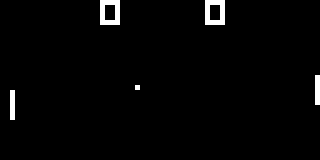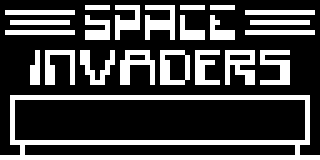CHIP-8 is an interpreted programming language, developed by Joseph Weisbecker. It was initially used on the COSMAC VIP and Telmac 1800 8-bit microcomputers in the mid-1970s. CHIP-8 programs are run on a CHIP-8 virtual machine. It was made to allow video games to be more easily programmed for said computers.
Roughly twenty years after CHIP-8 was introduced, derived interpreters appeared for some models of graphing calculators (from the late 1980s onward, these handheld devices in many ways have more computing power than most mid-1970s microcomputers for hobbyists).
CHIP-8 has 16 8-bit data registers named from V0 to VF. The VF register doubles as a carry flag.
CHIP-8 has two timers. They both count down at 60 hertz, until they reach 0.
| Opcode | Type | C Pseudo | Explanation |
|---|---|---|---|
| 0NNN | Call | Calls RCA 1802 program at address NNN. Not necessary for most ROMs. | |
| 00E0 | Display | disp_clear() | Clears the screen. |
| 00EE | Flow | return; | Returns from a subroutine. |
| 1NNN | Flow | goto NNN; | Jumps to address NNN. |
| 2NNN | Flow | *(0xNNN)() | Calls subroutine at NNN. |
| 3XNN | Cond | if(Vx==NN) | Skips the next instruction if VX equals NN. (Usually the next instruction is a jump to skip a code block) |
| 4XNN | Cond | if(Vx!=NN) | Skips the next instruction if VX doesn't equal NN. (Usually the next instruction is a jump to skip a code block) |
| 5XY0 | Cond | if(Vx==Vy) | Skips the next instruction if VX equals VY. (Usually the next instruction is a jump to skip a code block) |
| 6XNN | Const | Vx = NN | Sets VX to NN. |
| 7XNN | Const | Vx += NN | Adds NN to VX. (Carry flag is not changed) |
| 8XY0 | Assign | Vx=Vy | Sets VX to the value of VY. |
| 8XY1 | BitOp | Vx=Vx | Vy Sets VX to VX or VY. (Bitwise OR operation) |
| 8XY2 | BitOp | Vx=Vx&Vy | Sets VX to VX and VY. (Bitwise AND operation) |
| 8XY3 | BitOp | Vx=Vx^Vy | Sets VX to VX xor VY. |
| 8XY4 | Math | Vx += Vy | Adds VY to VX. VF is set to 1 when there's a carry, and to 0 when there isn't. |
| 8XY5 | Math | Vx -= Vy | VY is subtracted from VX. VF is set to 0 when there's a borrow, and 1 when there isn't. |
| 8XY6 | BitOp | Vx=Vy=Vy>>1 | Shifts VY right by one and copies the result to VX. VF is set to the value of the least significant bit of VY before the shift. |
| 8XY7 | Math | Vx=Vy-Vx | Sets VX to VY minus VX. VF is set to 0 when there's a borrow, and 1 when there isn't. |
| 8XYE | BitOp | Vx=Vy=Vy<<1 | Shifts VY left by one and copies the result to VX. VF is set to the value of the most significant bit of VY before the shift |
| 9XY0 | Cond | if(Vx!=Vy) | Skips the next instruction if VX doesn't equal VY. (Usually the next instruction is a jump to skip a code block) |
| ANNN | MEM | I = NNN | Sets I to the address NNN. |
| BNNN | Flow | PC=V0+NNN | Jumps to the address NNN plus V0. |
| CXNN | Rand | Vx=rand()&NN | Sets VX to the result of a bitwise and operation on a random number (Typically: 0 to 255) and NN. |
| DXYN | Disp | draw(Vx,Vy,N) | Draws a sprite at coordinate (VX, VY) that has a width of 8 pixels and a height of N pixels. Each row of 8 pixels is read as bit-coded starting from memory location I; I value doesn’t change after the execution of this instruction. As described above, VF is set to 1 if any screen pixels are flipped from set to unset when the sprite is drawn, and to 0 if that doesn’t happen |
| EX9E | KeyOp | if(key()==Vx) | Skips the next instruction if the key stored in VX is pressed. (Usually the next instruction is a jump to skip a code block) |
| EXA1 | KeyOp | if(key()!=Vx) | Skips the next instruction if the key stored in VX isn't pressed. (Usually the next instruction is a jump to skip a code block) |
| FX07 | Timer | Vx = get_delay() | Sets VX to the value of the delay timer. |
| FX0A | KeyOp | Vx = get_key() | A key press is awaited, and then stored in VX. (Blocking Operation. All instruction halted until next key event) |
| FX15 | Timer | delay_timer(Vx) | Sets the delay timer to VX. |
| FX18 | Sound | sound_timer(Vx) | Sets the sound timer to VX. |
| FX1E | MEM | I +=Vx | Adds VX to I. |
| FX29 | MEM | I=sprite_addr[Vx] | Sets I to the location of the sprite for the character in VX. Characters 0-F (in hexadecimal) are represented by a 4x5 font. |
| FX33 | BCD | set_BCD(Vx); *(I+0)=BCD(3); *(I+1)=BCD(2); *(I+2)=BCD(1); | Stores the binary-coded decimal representation of VX, with the most significant of three digits at the address in I, the middle digit at I plus 1, and the least significant digit at I plus 2. (In other words, take the decimal representation of VX, place the hundreds digit in memory at location in I, the tens digit at location I+1, and the ones digit at location I+2.) |
| FX55 | MEM | reg_dump(Vx,&I) | Stores V0 to VX (including VX) in memory starting at address I. I is increased by 1 for each value written. |
| FX65 | MEM | reg_load(Vx,&I) | Fills V0 to VX (including VX) with values from memory starting at address I. I is increased by 1 for each value written. |
Depends on OpenGL and GLUT
- Linux:
- Ubuntu: sudo apt-get install freeglut3-dev
- Fedora/RedHat: sudo yum install freeglut-devel
- Windows:
- Download link https://www.opengl.org/resources/libraries/glut/glut37.zip
- OS X:
- OpenGL and GLUT come with the OS and Xcode installations.
./CHIP8 game.c8
http://www.pong-story.com/chip8/ some games.


